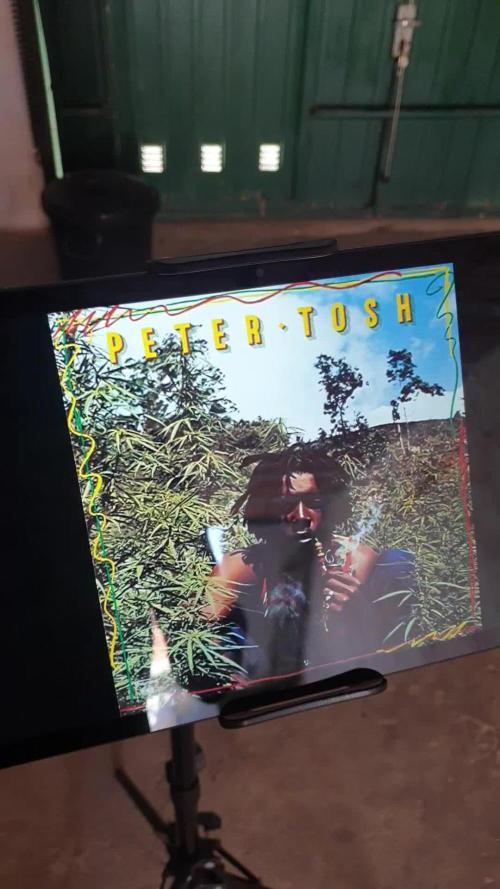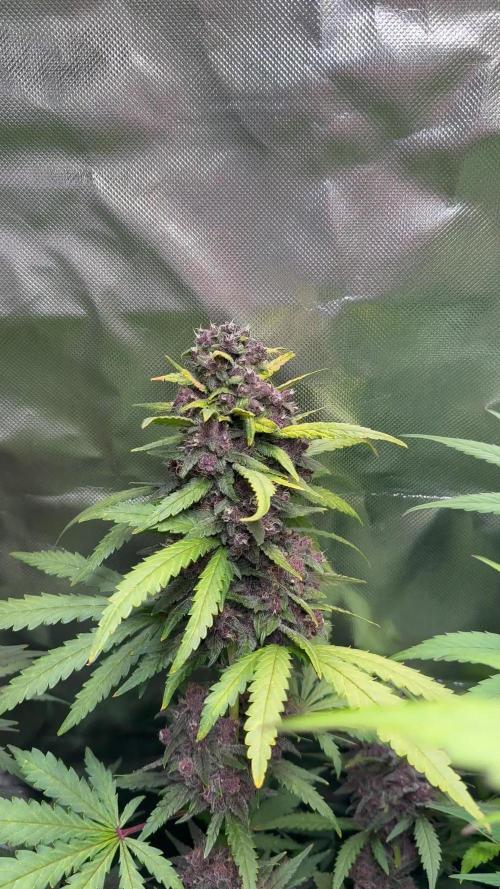The Grow Awards 2026 🏆 































Likes
12
Share


@Willy_Balls
Follow
First week of flowering.
Girls are super happy. And drink a lot. I very much prefer the lower plant count with 8 plants. And I’m probably not going to go back to more than 9 plants. Perhaps will even try 6 or 7. 12 or 16 was a bit of overkill. Maybe with super short veg it has its place.
26.01 first day of flower.
Likes
16
Share


@UnitedStrainsGermany
Follow
🌱 Eternity Cup 2025 – Woche 6 Update 🔥
Unser Eternity Cup 2025 Grow, powered by Zamnesia & Plagron, geht in die nächste Runde! 🚀 Die Runtz Autoflowers unter der Evo 301 (Samsung Chips, 180W) zeigen jetzt deutliche Unterschiede – jede Pflanze entwickelt sich nach ihrem eigenen Tempo. 🌿
🔍 Setup & Entwicklung nach 6 Wochen:
🌿 #1 – 20L Topf, nicht getoppt, aber LST
Diese Dame steht jetzt voll in der Blüte! 🌸 Dank des großen Topfes hat sie sich super entwickelt, schöne Buds setzen sich langsam an. Sie bleibt stabil und gesund – die LST-Methode zahlt sich aus! ✅
🌿 #2 – 8L Topf, getoppt & LST
Während die anderen zwei sich voll auf die Blüte konzentrieren, legt #2 nochmal ordentlich in die Breite zu! 📏 Das Topping und LST zeigen ihre Wirkung – die Pflanze bleibt kompakt, aber buschig. Die ersten Blütenansätze sind zu sehen, aber sie nimmt sich weiter etwas mehr Zeit. 🌱
🌿 #3 – 8L Topf, nicht getoppt, kein Training
Genau wie #1 steht auch diese Pflanze voll in der Blüte! 🌸 Sie ist von Natur aus etwas höher gewachsen und beginnt jetzt, schöne Buds auszubilden.
🌱 Fazit nach Woche 6:
Die ungetoppten #1 & #3 sind mitten in der Blüte, während #2 sich weiter in die Breite entwickelt und noch ein wenig hinterherhinkt. 🌱💪 Aber alle drei sind kerngesund, und es bleibt spannend zu sehen, ob sich das Wachstum von #2 am Ende durch höhere Buddichte auszahlt!
➡️ Wie wird sich der Blütenaufbau in den nächsten Wochen entwickeln? Bleibt #2 länger in der Vegi? Wir halten euch auf dem Laufenden! Stay tuned für Woche 7! 🔥
Update vom 25.02 die explodieren ich muss das Zelt wechseln maximal 1 Woche noch und sie kommen in das doppelt so große Zelt !!! Ich bin so Happy bitte schaut euch #1,#3 an das sind Autos
#EternityCup2025 #Zamnesia #Plagron #GrowDiaries #RuntzAuto #Homegrow #CannabisCommunity
Likes
7
Share


@Green_fingers
Follow
Just been chopped toon al the lower branches off and put them away separate but will update on the total yield
Likes
11
Share


@pegonter
Follow
Early skunk 2 and 4 stretched a lot this week while early skunk 3 didn't as much.
ES 3 development seems to be faster then 2's and 4's however is not gaining as much height and shoot structure as 2&4's.
Noticed little burning on ES4 leaves closer to ventilator.
La fanta CBD evolved a little this week, noticed by pistils finally developing on a fast rate.
17/10 Fed them with liquid quillaia extract, biosymphony (psb) and little lmx to the water reservoir. Last one in order to slow down algae dev on reservoir.
Likes
8
Share


@Herbman420
Follow
Hi everyone i just put the seed in today . I'm running it with Coco perlite and xpert nutrients will do updates in the week to keep you informed. Thank you for looking at the diary and a remember it's 420 somewhere 🌱
Likes
96
Share


@DogDoctorOfficial
Follow
Greetings, fellow cultivators! Today, I'm thrilled to share the grand finale of our journey with the remarkable Big Cheese Auto from Seeds Mafia. At day 81 from seed, she reached the pinnacle of her splendor, and the harvest was nothing short of spectacular.
As I gently snipped each ripe bud, I couldn't help but marvel at the beauty and resilience of our Big Cheese Auto. From the moment she emerged as a seedling, she embodied strength, vigor, and an unwavering determination to flourish. Now, as she hangs upside down to dry for the next two weeks, I'm filled with a profound sense of gratitude for the privilege of witnessing her growth.
Our journey with the Big Cheese Auto has been nothing short of extraordinary. From the excitement of germination to the meticulous care during vegetative growth, from the anticipation of flowering to the aromatic crescendo of the harvest, each phase has been a testament to the plant's resilience and the joy of cultivation.
The journey began with a tiny seed, a promise of potential waiting to be fulfilled. With the nurturing support of the Autopot system and the guidance of Aptus Holland's nutrients, our Big Cheese Auto thrived, transforming into a botanical marvel with each passing week. From the emergence of her first true leaves to the explosion of trichome-rich buds, she captivated us at every turn.
A heartfelt thank you to Seeds Mafia for providing the genetics that sparked this incredible journey. Your seeds have not only produced exceptional plants but have also inspired a community of passionate cultivators. Your dedication to quality and innovation is truly commendable, and I am grateful for the opportunity to cultivate such remarkable genetics.
Before the trimming and curing process begins, I took the time to capture the beauty of our Big Cheese Auto in a special photo shoot. Each snapshot is a testament to her magnificence, a visual ode to the journey we've shared together.
To the entire community, both near and far, thank you for accompanying me on this horticultural odyssey. Your support, encouragement, and shared passion for cultivation have made this journey all the more rewarding. Let's continue to cultivate greatness together!
Thank you for being a part of this incredible journey! Wishing you all abundant harvests and joyful cultivation endeavors ahead!
Genetics -Seeds Mafia Big Cheese Automatic
Light - LUMATEK ZEUS 465 COMPACT PRO
Food - APTUS HOLLAND
All info and full product details can be find in can find @
https://seedsmafia.com
https://aptus-holland.com/
https://lumatek-lighting.com/
As always, thank you all for joining me on this journey, for your love, and for it all. My horticultural odyssey would never be the same without you. Your love and support are cherished, and I feel both honored and blessed to have you in my life
Likes
3
Share


@jimifarmer
Follow
This week it was time to transplant the plant into a 50L pot. On Sunday, I prepared the soil while listening to Peter Tosh and then transplanted the little one. It didn't even feel the effects of the transplant and is now looking beautiful in the sun. I plan to mainline this plant, so I'll do the apical pruning later this week to make the process as quick as possible.
Likes
6
Share


@Canaryweed_tf
Follow
Hola buenas, aquí tenemos la primera semana de las maravillosas PurpleKush feminizadas de nuestra familia de @Kannabiaseeds. En está primera semana han ido creciendo muy bien, tienen muy buena estructura y muy buen color. Las he regado aparte de agua con fertilizantes de enraizamiento de la marca @Boomnutrients y vitaminas de la marca @ProXLComplete&Concentrated. 😘
Likes
52
Share


@WhiteEdge
Follow
12.03.2024
Continue into week two. Target EC is the same for this week
Girls looking great
Clean tanks and filters with h2o2+vinegar acid +bleach
Replace all filters
Mix new batch with 2ml AN connoisseur AB + Silica @ 1% H2o2 - total 30l
Donne one pass off long misting 2m
700 PPFD @ center, VPD 1.0, RH 53-56% day, RH 45-48% night, Temp Night-20c, Day-25/26c, Leaf temperature 23c, Light distance 60-65cm, CO2 750+ppm
560w@60cm distance
NT-Nutrient Tank - PH -5.9, EC -1.15, Temp-21c
13.03.2024
Top up tank with 10l off 1.2EC solution - 2ml AN Connoisseur A+B + 3g Big Bud @ 18l (1.16EC)
Replace all filters
Before top up, nutrient solution in tank was 0.84, after adding 1.2EC new mix is 1.03
PH is slightly rising, normal when EC is drooping
Girls grow nicely, no deficiencies, this week is start off stretchy faze
Remove some big and bottom leves
PAR 800 PPFD, VPD 1.0-1.1, RH 50-54%, Temp Night-21-22c, Day-25/26c, Leaf temperature 23c, Light distance 60cm, CO2 750+ppm
580w@60cm distance
50s ON time 20min OFF time Day Time
50s Off time 30min OFF time Night Time
NT-Nutrient Tank - PH -5.92-5.99, EC -0.89-1.0, Temp-20-22c
14.03.2024
Position TrolMaster Tent-X Box on tent and connect to internet. Temperature ,Light and humidity sensor is great, I lake that all sensors and connector boxes are on RJ connectors
Great and fast install, registration and connections off all cables, censors and light! Like ability to expand system with Aqua-X and Hydor-X for irrigation ,PH/ EC/Temp monitoring off nutrient tank
Controlling solenoid valves and pump will be SUPERB!!! Recycling type off timer are great for Aero misting!
With Inkbird equipment i have issues that all connections are permanent and if you have longer cables....😡
HLG Scorpion Diablo LED light is connect via LMA-14 light adapter ! Wow i can control dimming and timing off my light via Wi-Fi😀😊😎👏🙏🙌
PAR map 800max/600min PPFD, VPD 1.0-1.1, RH 50-54%, Temp Night-21-22c, Day-25/26c, Leaf temperature 23c, Light distance 60cm, CO2 750+ppm
HLG Scorpion Diablo@83%
580w@60cm distance
50s ON time 20min OFF time Day Time
50s Off time 30min OFF time Night Time
NT-Nutrient Tank - PH -5.95-5.99, EC -0.89-1.1, Temp-20-22c
15.03.2024
Top up tank with 15l off 1.2EC solution - 2ml AN Connoisseur A+B + 3g Big Bud @ 18l (1.16EC)
Replace all filters, still everything in pristine condition after every changing, nutrient solution in tank looking and smell fresh and clean.
Reducing humidity in night time below 50% , humidifier rise temperature to 22-23c at night
Day RH is 53%, in first two hours keeping temps and humidity lower to reduce deferential form night time to 1-2c
Don't want to have more than 10-15cm off stretch in next week
Girls drink more water and nutrients every day, think around 10-12l per day
Managing EC strength with adding slightly higher nutrients solution when top up tank. Overall its around 0.9-1.0EC for most of the time
PH is stabile , slowly rise in small increments. Need to adjust @ 6.2 to 5.9 every two-three days. Probably i will leave it to swing even more.
Diablo is at 80% power @ 45-55cm from top canopy, 900+PPFD in center, lowest corners get 650+
PAR map 920max/650min PPFD, VPD -1.1, DRH 50-54%, NRH48-50%, Temp Night-21-22c, Temp Day-25/26c, Leaf temperature 23c, Light distance 45cm, CO2 750+ppm
HLG Scorpion Diablo@80%
580w@45cm distance
50s ON time 20min OFF time Day Time
50s Off time 30min OFF time Night Time
NT-Nutrient Tank - PH -5.95-5.99, EC -0.89-1.1, Temp-20-22c
17.03.2024
Top up tank with 10l - 1.2EC solution - 1.8ml AN Connoisseur A+B + 3g Big Bud @ 18l (1.16EC)
Replace all filters, install one new. Total 5 mash filters + 2 disc filters
Remove some large fan leaves from all girls. Nothing crazy. Next week is final BIG defoliation and pruning
Clean room benches a little bit after defoliation.
Whole week all girls are doing great , no sign off any kind off stress or deficiencies. Superb fast growth.
Stretching is more apparent in the end off this week. Next week is going to be madness!
18.03.2024
Raise light 10cm , adjusting to canopy level..
HLG Scorpion Diablo@83%, Set sunrise/sunset dimming @ 30min - TrolMaster Tent-X
PAR map 890max/650min PPFD, VPD -1.1, DRH 50-54%, NRH48-50%, NT-21-22c, DT-25/26c, Leaf temperature 23c, Light distance 45cm, CO2 750+ppm
Week 2 off Flowering in Summary
100l off RO water
190ml+190ml AN connoisseur A+B, 15g Big Bud Powder
70kW electricity in total for light, Pumps and AC Infinity Fans. 58kW for Light + 8kW Dehumidification + AC Infinity ventilation
Week start @ 1.14EC, nutrient strength. Strength dropping every day by 0.1-0.2. Topping up tank with 1.2EC solution bring back strength to 0.9-1.0EC
Start using AN Big Bud powder for day two off this week. For next slowly reducing Nitrogen and add more Big Bud. Next week start @ 1.2EC
Girls look superb all time, Tropicana Cookies is short and bushy with lots off side branching. Need good defoliation next week .
Flowering going nicely, obvious sign off formation off bud sites, pistils have shown an all girls.
PH was stabile and move from 5.85 min to 6.2 max. Swing all week without chasing perfect number.
Light distance start at 65cm from canopy finish week at 45-50cm , PPFD levels around 800-940 in center, trough whole week
Temperature vary slightly from 23c at start off day to 26c max at some points. AC Infinity T6 extracting fan program in AUTO to kick in @ 26c
Night temps around 21-23c, dehumidifier start to work at night time to bring down humidity, trying also to minimize Day/Night temperature differential for this week also
Continue in next week at same environment settings and light strength..
Likes
13
Share


@russrahl
Follow
This girl is looking delicious! She’s not packing it on quite as much as the Obi-wan’s are, but they are so beautiful looking. Just covered in tricombs everywhere. She is starting to show signs of pk deficiency, older leaves are starting to yellow and we are now seeing the hairs starting to recede and some turning red. Probably be harvesting her first before the other 3 obi-wan girls as she looks to be slowing down faster...if that makes any sense...lol I’m not planning on doing a lengthy flush on her so I’m thinking we will wait till we see all cloudy tricombs and then give her a week or so flush till we start seeing about 20% amber. Well that’s it for this week! Cheers 💨
Processing
Likes
2
Share


@DIRTYKEG
Follow
Fun time im excited it's turning out pretty good allot allot of learning as you go but it's working I think... the GSC started dropping a couple leaves but I think it v was just cause it got to dry flowering stage seems to suck up allot more water....
Likes
4
Share


@Nocone_Purple
Follow
This week the Blackberry shows a solid progression into the late flowering stage. Buds are already dense with a nice resin coverage and the aroma is becoming more intense. From now on I’m stopping Big Bud and switching to Overdrive for the next two weeks. The reason for this is that Big Bud is mainly focused on building bud size and structure during mid-flower, while Overdrive is formulated for the final phase, helping the plant push out extra weight, density, resin and terpenes before the flush. This way the Blackberry can fully focus on ripening and maximizing quality in the last stretch.
Likes
4
Share


@DatGuyGrows
Follow
Grown out this week and got them ready for the early flower growth. Trimmed heavy and wired all branches away from each other. LST in full effect. Hoping it’s not too much trauma for them.. they proved me wrong. Bounced back with vigor and bright excitement! Eager to see these buds start forming 👀
Likes
4
Share


@AustinRon
Follow
El Diablo Week 13 - Harvest
[Twenty20Mendocino]
(X-Factor X Whiskey Zulu)
Overview -
- We’ve lowered Lighting to 75%, in an attempt to to lower overall temperature through end of grow.
- Full Watering every 3 - 4 days
Objective
- Trained Plant - @3Nodes - Bend apical meristem to Node 1 Height, 7 STEMS . . .
Week 13 : [ Fri
Apr 11, 2025, ED 1Q25 1:H:0:1]
[ Thu Apr 17, 2025, ED 1Q25 7:H:0:7]
24/0 @ Germination through 24 Hour Open Cotyledons (then 18/6)
Germination: 25 Jan 2025
Harvest Date: Thu Apr 23 2025
__
Wed Apr 23, 2025
ED 1Q25 1:H:0:1
- [x] Remove Cabinet Lights
- [x] Replace Fan (Clean)
- [x] Clean Cabinet
- [x] Wash Replace Cabinet Filters
- [x] Drop Pot/Photograph Root Ball
Taken Down and HUNG TODAY
Whole Plant Weight (Wet): [ 458, g]
Estimate 90 grams Dry, approximately 3 oz.







Likes
13
Share


@wheedtobeus420
Follow
She’s finally finished I’m so happy to have her. She smells like red starburst and zkittlez. She taste like she smells. I’m very happy how she turned out. Beautifully. Super sweet and right up my alley. Fastbuds hits it out of the park once again!
Likes
34
Share


@Bluntblazer66
Follow
Feb 8th
Starting to learn how to grow with the new system
I have had a couple of learnings so far
1 The PH level is getting to high by the time it’s in the autopot from the res being keep below 6.0
I try to keep the PH in the res around 5.7
By the time it’s in the plant trays it is testing to be around 6.5 and above.
So I’m trying to work that out
Also started LST this week




























